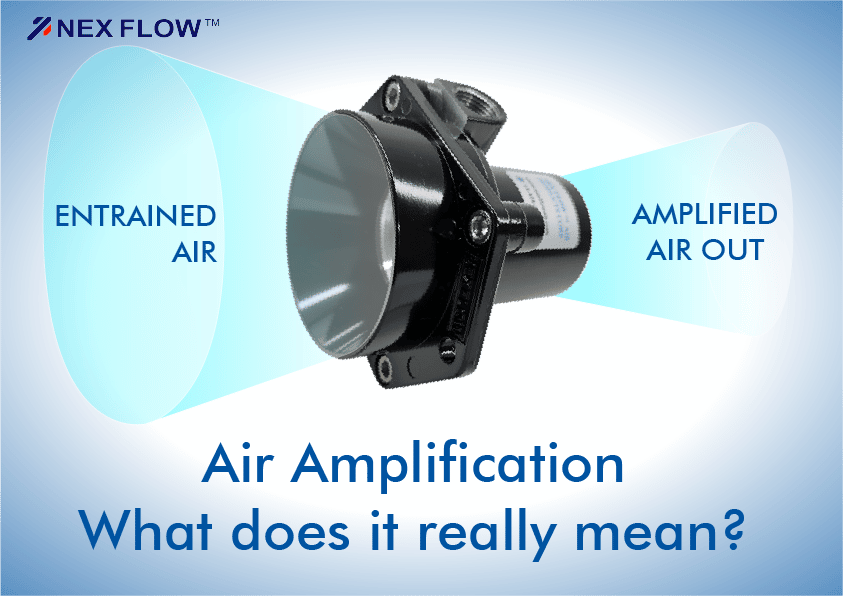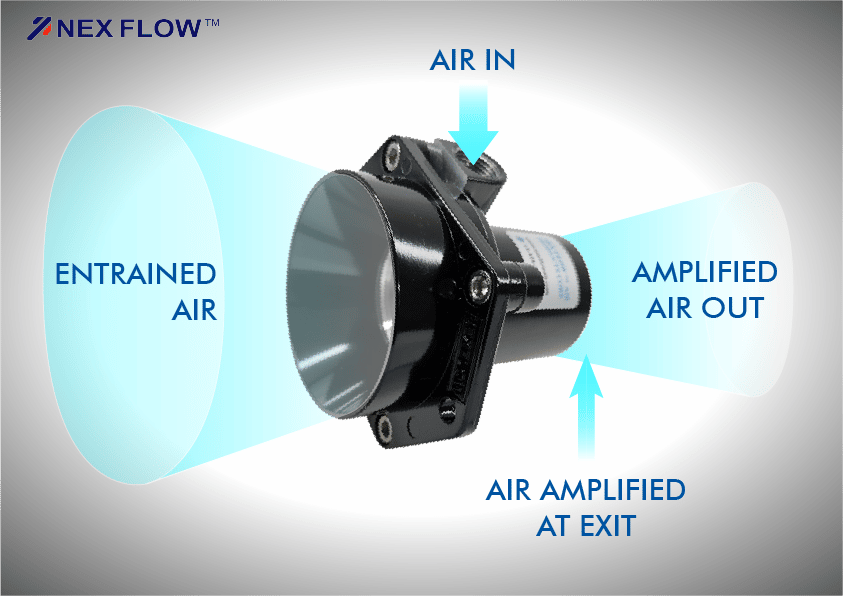
Since getting involved with air nozzles, air knives and other compressed air operated blow off products, one term that keeps getting used and abused is the term air amplification. There is sometimes a false impression created that the larger the number, the more effective is the output and efficiency of an air nozzle air knife or air amplifier. That is not necessarily the case.
Engineered air nozzles, air knives, air jets and air amplifiers typically use special aerodynamic shapes to produce much greater flow, high velocity and a blow off force at a greater distance from the device for any given air consumption. But this does not mean that the higher the air amplification after a certain value, that the force, velocity or flow continues increase proportionally at an indefinite rate and in fact, can decrease if this value is too high. There is a practical limit from simple physics. The term air amplification has been around for years but it is more accurately described as energy conversion – converting energy normally lost as pressure drop and noise, into flow.
When compressed air exits any opening, even an inefficient crimped copper tube, the air flow will entrain some atmospheric air. It varies with distance, with temperature, density, pressure and all sorts of factors but the average figure used is as follows; at a distance of 6 inches after exiting, the moving airflow will entrain about three times the air volume that exits the opening. That is an air amplification ration of three times. As this happens, because you are entraining still atmospheric air, you will start to slow down the velocity of the moving air. The way to make any blow off product more powerful, fast and efficient is to increase the output right at the exit before this “downstream” entrainment. For a crimped tube or open pipe, that ratio at the air exit is one to one. Engineered nozzles and amplifiers attempt to improve on that ratio.

The aerodynamic design of engineered nozzles, air knives etc. do this by “recovering” energy that is normally lost as pressure drop and noise level right at the exit of the blow off product. In doing this effect, the pressure of the exiting compressed air must drop. However, the flow tends to remain laminar at this exit point and maintain its laminar flow over a much longer distance. This is what maintains a concentrated force after a long distance as well as high velocity because turbulence is avoided. The actual force “at a distance” coupled with the added mass flow due to entrainment, albeit at a lower pressure, remains quite powerful and effective. As an example, a 2” air amplifier like the Nex Flow Model FX40 has an amplification ratio of 15:1 at the exit point. That is quite a high ratio. The effective air amplification 6” downstream will now be 3 X 15 or 45 times. The mass flow, and velocity at the exit will slow as it entrains that downstream value. But what happens if the amplification ratio is much higher at the exit and, is it reasonable. When there is air amplification the downstream velocity, and force does not go up linearly with amplified flow. In fact, as downstream entrainment occurs, the velocity and force will decrease if the amplification ratio is too high.
In applications where high air pressure is required, then air amplifying nozzles will not always work but, the target of the flow must be close to the air exit of the tube or pipe used in that case. This is because air flow will be turbulent and the force and velocity will dissipate very quickly with distance. Reasonable air amplification “at the point of exit” from an air amplifier, or nozzle can be in the range of 6 to 16 times at the exit. Any more that that is first of dubious based on shear physics and should be questioned. At 6 inches away another 3 times amplification occurs to that recovered figure at the exit. For an X-Stream air blade air knife for example, the amplification ratio is usually about 40 times at 6 inches from the air exit gap. That figure comes from using 3 times downstream entrainment coupled with the recovered energy amplification or about 13 at the air gap exit. For standard air knives, it’s about 30 times at the 6” distance or 10 times at the exit. For air nozzles, air jets and annular air flow amplifiers, it is dependent on the physical size and geometry becoming more effective for flow amplification as the size goes up and can go from 6 times to 16 times at the “exit” of the product. If you see higher figures, you should question them – not because it may or may not be correct, it’s whether what you really need that high a mass flow, and whether velocity and force is going to be what you expect and require.
By understanding the above, a few facts become clear. First, the very term air amplification implies you need to know where that the value applies – at what particular point – either at the exit of the compressed air from the device, or at some distance from the device. Second, air amplification by its nature implies that the higher the value, the greater the flow but… the force and velocity will be less after some optimum amplification point. So at some level, the air amplification can be too high and may actually produce less effective force and velocity at the target.
Some interesting claims have been made for “air amplification”. We describe two as follows:
- One is a claim that a particular shim design can direct compressed air at the exit in such a way to increase air amplification by over 60% at the exit point. In other words, you get a lot more flow from a given air consumption. The result interestingly enough, has improved business for Nex Flow because these amplifiers did not work as well as previous designs with less air amplification because of inadequate force and velocity. Logically, a greater air amplification ratio beyond an optimum point, may result in more air flow but lower velocity and less force at the target. Both are undesirable results if the use is for blow off or cooling. If the devices are used for venting it would be advantageous although no data is available on any increased or negative change in the effect of back pressure. That can also be a negative factor. There is a balance to what is a reasonable air amplification ratio for an effective result.
- Another claim is which we have seen is with compressed air operated air knives. One design with two exit gaps for compressed air claims air amplification of 50 times against claims of most others of 40 and 30 times. Same reasoning applies in that flow may be more but force and velocity may be negatively affected. No distance from the exit is mentioned to determine this amplification as point of reference. If it’s a single gap in an air knife that someone claims is 50 times, it should be highly suspect.
Rather than focus on the term “air amplification”, we recommend that you focus more closely at the results you need and look at measured data on force and velocity and the actual air consumption. What is the force at a given distance? What is the velocity? Check the compressed air consumption against the force and velocity produced. What you really need is a high force and velocity ratio to air consumption. That will give a true reading of efficiency that is both useful and understandable. Of course – make sure those published values are valid as well. When using air flow amplifiers for venting, any attachment at the exit – a hose or pipe, will create some back pressure that will dramatically reduce the back pressure. Sensitivity to back pressure is important and the higher the amplification ratio, typically the more sensitive to back pressure the device will be as well.
In summary, recognize that air amplification and the term “amplification ratio” is a guide to efficiency but more of a qualitative indicator that is often not clearly defined as to how it is obtained. If the value appears out of the ordinary, it should be suspect.
To get a true measure of efficiency, check the measurable results – air consumption, velocity, force, and especially force/ air consumption ratio which is a realistic and objective indication of efficiency that is both verifiable and useful in determining its effective use in any given application.





